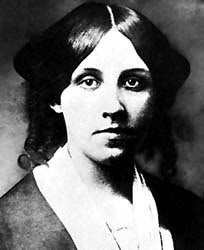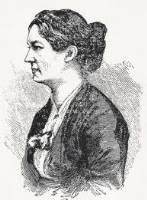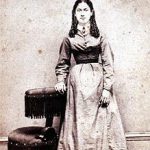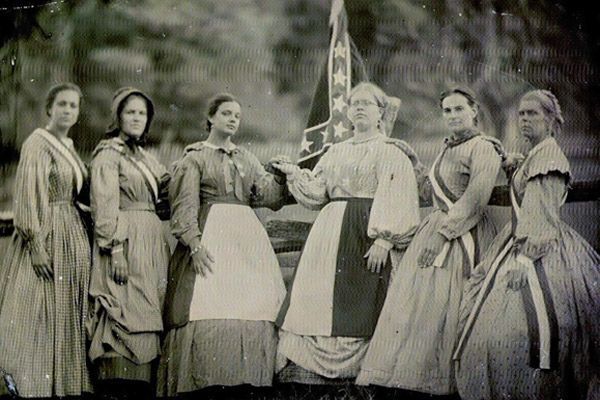Woman Telegraph Operator in Missouri

Louisa Volker became a Union telegrapher in Missouri during the Civil War. Her intelligence activities put her at risk of capture because Confederate raiders in the area often kidnapped the local telegrapher when they invaded a town, and forced him to intercept messages from, or send false reports to, the enemy.
Louisa Volker was born in St. Louis, Missouri, in 1838, the daughter of German immigrants. Her father Emanuel Volker was a grocer. Louisa had an older sister, two younger sisters and a brother.
In the 1840s, Emanuel Volker purchased land in the city of St. Louis and surrounding counties. In the 1850s, the female members of the family, including Louisa, participated in these land transactions. It was very unusual during that era for women to own property. The Volkers were fairly prosperous during the decades leading up to the Civil War.
Around 1860, the family moved from St. Louis to Mineral Point, where Mr. Volker was listed as a tavern keeper in the 1860 census. Louisa, then 22 years of age, was still residing with her parents.
Mineral Point was an important junction on the St. Louis and Iron Mountain Railroad. With the adoption of the telegraph as a signaling system by the railroads, it became common for women to work as telegraphers and station agents. Louisa learned telegraphy from Mr. Barrett, who was the operator at the railroad depot in Mineral Point at that time.
By July 1861, Union General George B. McClellan already had field telegraph facilities as he moved his army through western Virginia. By the spring of 1862, McClellan could communicate directly with his generals across vast areas of the country.
Sometime around the beginning of 1863, Louisa Volker became a member of the Military Telegraph Corps of the Union Army. She probably volunteered and was accepted due to the shortage of telegraph operators in the area.
An account of Volker’s work appeared in William R. Plum’s book, The Military Telegraph During the Civil War in the United States, in which he wrote:
About seven months previous, Miss Louisa E. Volker, a most estimable young lady, had relieved C. T. Barrett, operator at Mineral Point, and became at once not only the first lady operator in the corps, west of the Mississippi, but the only operatrix who had ever telegraphed on that side of the river.
In November 1863, Louisa transferred ownership of a block of land and several lots in Mineral Point to her brother-in-law. She may have transferred ownership of the land to prevent it from falling into the hands of the Confederates.
Her intelligence activities at Mineral Point, Missouri, put her at risk of capture during Confederate General Sterling Price’s invasion of southern Missouri in the autumn of 1864. Confederate raiders often kidnapped the local telegrapher when they invaded a town, and forced him to intercept messages from, or send false reports to, the enemy.
On September 19, 1864, Price crossed over into Missouri with a force of about 12,000 men. He planned to capture St. Louis and Jefferson City, and install a secessionist government. He mistakenly believed that there were many Confederate sympathizers in the area.
One of Price’s primary targets was the town of Pilot Knob, which was south of Mineral Point. Union supply depots and iron works were located there. Union forces under Major General A. J. Smith were camped near Mineral Point. Smith’s job was to defend the railroad from the Confederate raiders. This put Louisa in a position of great importance as the only telegraph operator in the area.
Plum’s account continued:
A train laden with soldiers and refugees, including the telegraph operator from Irondale (Missouri) was delayed in consequence of injury done the road near the Point. The attack on the train which followed was repulsed, the track repaired, and the train saved. By this time the woods were filled with Confederates, and picket firing began. Miss Louisa Volker, operating at the Point, having been at her instrument continuously for two days and nights, was relieved by the Irondale operator.
By the morning of September 27, the Rebels had destroyed the track south of Mineral Point and had cut the telegraph wires. Confederate Colonel B. Frank Gordon was then ordered to attack Mineral Point.
Plum gave this account of the invasion of Mineral Point :
Miss Volker and sister remained to protect their father’s home from destruction. After hiding all evidences of her employment, and placing a pistol in her pocket, with a fixed purpose of defending herself and sister against violence, she overlooked the little village from her window, and discovered Confederate cavalrymen, ragged and dirty, with ‘lean and hungry’ looks, suddenly possess the place and begin their ravenous search for food, not to mention their hunt for plunder.
Volker’s house was soon filled by men who stole blankets and clothing, and helped themselves to the edibles at the same time. Miss Volker now discovered the depot, tank and engine-house in flames.
Night approached, and darkness and imagination multiplied terrors, in Volker’s house at least. The two young ladies, armed with pistol and their father’s shot-gun, stood in the center of a room, still as death, listening intently. Morning brought report that St. Louis was captured. Not long after, an unfounded rumor that Indians had deluged Potosi, Missouri, in blood, stampeded the women and children from Mineral Point.
The rumors were false. The Yankees had repulsed the first attack by the Confederates, then slipped out of town. Price launched a second attack at dusk. Finding his enemies gone, Price then turned westward, his raid into southern Missouri a dismal failure.
During the war, Louisa made the acquaintance of Thomas Hanlon Macklind, a lawyer and civil engineer in Potosi. He had been born in Ireland and came to the United States with his parents. He was educated at the Franklin Institute as a civil engineer, and moved to Missouri in 1856, where he worked on the construction of the railroad. While at Potosi, Thomas studied law, and was admitted to the bar in 1860.
In May 1865, Thomas and Louisa were married. They moved to St. Louis, where Macklind became an engineer with the Street Department, where he continued to work until his death in 1904. Louisa gave birth to a son in 1869, and another in 1880.
Prior to the Civil War, most clerical work was performed by men. During the war, women were employed for clerical duties by the Treasury Department, and they began to enter the field of general office work.
In the 1870s, Louisa became interested in a new field opening to women—stenography. Stenographers took dictation from a speaker, then formatted their notes into a letter or memo. Louisa learned stenography, and gave free lessons to poor girls in the city.
But Louisa was not finished yet. In 1895, at the age of 58, she graduated from Women’s Medical College in St. Louis, and was licensed to practice medicine. The college had been founded in 1892 to provide women with medical training. The school was the subject of constant controversy. Its graduates were denied internships in local hospitals, and the school closed a year after Louisa received her degree.
In 1895, Louisa received a Certificate of Honorable Service for her work as a telegrapher during the Civil War. What an overachiever she was!





